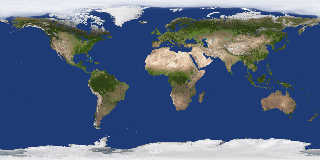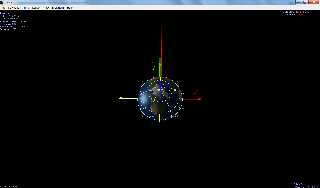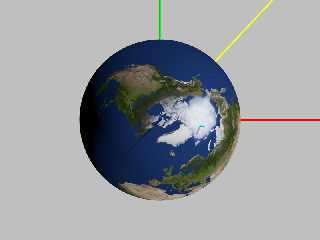 |
 |
|
 |
|
 |
|  |
|  |
|
 |
|
 |
|  |
|  |
|
 |
On 9/15/2018 1:07 PM, Mike Horvath wrote:
> I'm trying to adapt the following PDF to POV-Ray code for my
> planetarium/orrery.
>
> https://ssd.jpl.nasa.gov/txt/aprx_pos_planets.pdf
>
In Step 6 of that PDF, it gives an equation on how to convert between
ecliptic coordinates and J2000 coordinates.
What is the inverse of that equation, and how do I change it into a
series of `rotate` commands instead?
Thanks.
Mike
Post a reply to this message
|
 |
|  |
|  |
|
 |
|
 |
|  |
|  |
|
 |
On 9/20/2018 8:17 PM, Mike Horvath wrote:
> On 9/15/2018 1:07 PM, Mike Horvath wrote:
>> I'm trying to adapt the following PDF to POV-Ray code for my
>> planetarium/orrery.
>>
>> https://ssd.jpl.nasa.gov/txt/aprx_pos_planets.pdf
>>
>
> In Step 6 of that PDF, it gives an equation on how to convert between
> ecliptic coordinates and J2000 coordinates.
>
> What is the inverse of that equation, and how do I change it into a
> series of `rotate` commands instead?
>
> Thanks.
>
>
>
> Mike
I found the inverse on Wikipedia.
https://en.wikipedia.org/wiki/Ecliptic_coordinate_system#Conversion_between_celestial_coordinate_systems
Still not sure how to replace the equation with a series of `rotate`
commands though.
Mike
Post a reply to this message
|
 |
|  |
|  |
|
 |
|
 |
|  |
|  |
|
 |
Found a document with a table of values:
https://astropedia.astrogeology.usgs.gov/download/Docs/WGCCRE/WGCCRE2009reprint.pdf
The pertinent variables are alpha, delta and W. What do I do with these
variables? Dunno for sure. This document provides a formula:
https://depositonce.tu-berlin.de/bitstream/11303/6237/4/burmeister_steffi.pdf
I /think/ I need to rotate around the z-axis by W, around the x-axis by
(90-δ), and around the z-axis again by (90+α), in that order. Lastly, an
additional rotation (around the x-axis?) by 23.43928 degrees must be
done to get the body out of the ICRF frame and into the ecliptic frame.
But I still don't know the starting conditions. I.e. before applying the
transformations, should the globe's North Pole point upward? Should the
intersection of the Prime Meridian and Equator lie along the x-axis?
Also, am I wrong, and should I perform the inverse matrix calculations
instead? Either way, I have not gotten results that match what I see in
Celestia for the same Julian Date.
Mike
Post a reply to this message
|
 |
|  |
|  |
|
 |
|
 |
|  |
|  |
|
 |
Le 25/09/2018 à 07:39, Mike Horvath a écrit :
> Found a document with a table of values:
>
> https://astropedia.astrogeology.usgs.gov/download/Docs/WGCCRE/WGCCRE2009reprint.pdf
>
>
> The pertinent variables are alpha, delta and W. What do I do with these
> variables? Dunno for sure. This document provides a formula:
>
> https://depositonce.tu-berlin.de/bitstream/11303/6237/4/burmeister_steffi.pdf
>
Read start of 1.3, alpha, delta & W are defined there.
>
> I /think/ I need to rotate around the z-axis by W, around the x-axis by
> (90-δ), and around the z-axis again by (90+α), in that order.
W is the "day" part of the planet, adjusting the prime meridian.
Right-handed system, so, yes, W is for z-axis when applied first.
Otherwise, it would be applied along the rotation axis of the planet
once transformed from z by alpha & delta.
Figure 1.3 , page 11
From the point gamma on ICRF equator, starting sphere, the axis of
rotation of the planet is located at 90°+alpha, for an amount of
90°-delta. (a single tilting of the planet axis, along a single
perpendicular axis)
If I assert +x is gamma at start, +z north, you have to apply a rotation
along v_rotate( y, alpha*z) of 90°-delta, then a rotation of W along the
new pole axis.
You can of course transfer the W part before the other rotation, as it
is simpler to use z.
> Lastly, an
> additional rotation (around the x-axis?) by 23.43928 degrees must be
> done to get the body out of the ICRF frame and into the ecliptic frame.
That's a change of referential, the matrix should be well-known. (i.e. I
have no clue)
I do not know the x,y,z of ICRF(2) compared to the ecliptic plan and the
vernal point.
>
> But I still don't know the starting conditions. I.e. before applying the
> transformations, should the globe's North Pole point upward? Should the
> intersection of the Prime Meridian and Equator lie along the x-axis?
Yes. x2.
> Also, am I wrong, and should I perform the inverse matrix calculations
> instead? Either way, I have not gotten results that match what I see in
> Celestia for the same Julian Date.
>
>
> Mike
Post a reply to this message
|
 |
|  |
|  |
|
 |
|
 |
|  |
|  |
|
 |
Thanks for taking a look!
> Figure 1.3 , page 11
>
> From the point gamma on ICRF equator, starting sphere, the axis of
> rotation of the planet is located at 90°+alpha, for an amount of
> 90°-delta. (a single tilting of the planet axis, along a single
> perpendicular axis)
>
> If I assert +x is gamma at start, +z north, you have to apply a rotation
> along v_rotate( y, alpha*z) of 90°-delta, then a rotation of W along the
> new pole axis.
>
I can't quite understand your steps. Do you want me to do this?
#declare sphere_coo = vrotate(y, (90+alpha_0) * z);
#declare sphere_coo = vrotate(sphere_coo, (90-delta_0) * x);
OTOH, I have attached my scene so far if you would please look at it.
The result is not similar to what I see in the program Celestia for the
same Julian day. (I have attached a screenshot of that program as well.)
Mike
Post a reply to this message
Attachments:
Download 'do_not_delete.pov.txt' (5 KB)
Download '2k_earth_daymap.jpg' (453 KB)
Download 'celestia_screenshot_01.png' (130 KB)
Preview of image '2k_earth_daymap.jpg'

Preview of image 'celestia_screenshot_01.png'

|
 |
|  |
|  |
|
 |
|
 |
|  |
|  |
|
 |
Oops, here are the files once again. (Ignore the previous ones.)
Mike
Post a reply to this message
Attachments:
Download 'celestia_screenshot_01.png' (130 KB)
Download 'do_not_delete.pov.txt' (5 KB)
Download '2k_earth_daymap.jpg' (453 KB)
Preview of image 'celestia_screenshot_01.png'

Preview of image '2k_earth_daymap.jpg'

|
 |
|  |
|  |
|
 |
|
 |
|  |
|  |
|
 |
Le 26/09/2018 à 08:52, Mike Horvath a écrit :
> Oops, here are the files once again. (Ignore the previous ones.)
>
>
> Mike
I added the tilting axis (yellow) of the planet and the relevant
transformation.
I do not touch obliquity.
#declare TILT_AXIS = vrotate( x, (90+alpha_0)*z );
/* same as
#declare TILT_AXIS = vrotate( y, alpha_0*z );
*/
#include "transforms.inc"
#declare sphere_trans = transform
{
rotate z * W
Axis_Rotate_Trans( TILT_AXIS, 90-delta_0 )
//rotate x * (90-delta_0)
//rotate z * (90+alpha_0)
rotate x * -obliquity
}
Post a reply to this message
Attachments:
Download 'step.png' (163 KB)
Download 'step.pov.txt' (4 KB)
Preview of image 'step.png'

|
 |
|  |
|  |
|
 |
|
 |
|  |
|  |
|
 |
Thanks again for the help!
A couple of comments:
1. What is the significance of the long yellow cylinder?
2. The render of "step.pov" you posted still does not look like the
Celestia screenshot. The Celestia screenshot in my last post is what the
scene *should* look like, and the scene is off by quite a bit. I'm not
sure what's wrong, either.
Mike
Post a reply to this message
|
 |
|  |
|  |
|
 |
|
 |
|  |
|  |
|
 |
Am 26.09.2018 um 19:45 schrieb Mike Horvath:
> 1. What is the significance of the long yellow cylinder?
Looks like direction to the sun.
Post a reply to this message
|
 |
|  |
|  |
|
 |
|
 |
|  |
|  |
|
 |
On 9/26/2018 1:47 PM, clipka wrote:
> Am 26.09.2018 um 19:45 schrieb Mike Horvath:
>
>> 1. What is the significance of the long yellow cylinder?
>
> Looks like direction to the sun.
>
No, on Julian Date 2458383.5 the Sun should be directly along the -x axis.
Mike
Post a reply to this message
|
 |
|  |
|  |
|
 |
|
 |
|  |




![]()